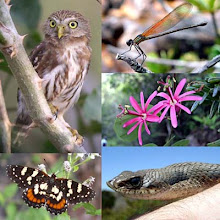August 27,
2015
The amazing
eyes of Fabrice spotted our first Jaguar this morning. It was tucked under the
foliage a bit, sitting on a bank overlooking the Tres Irmãos River. Our group
is in three small boats, but the two of us in front were able to turn around
just in time to see it lying there then get up and disappear into the forest.
Fabrice managed one quick photo.
We waited
around a bit to see if it would reappear, and at least four other boats
arrived, hoping for the same. The river vegetation here was very dense, and it
didn’t look as if there would be a place for it to reappear. While waiting we
spotted group of Alouatta caraya,
Black Howler, apparently looking down on the jaguar.
I then
decided we could see more birds and maybe even another Jaguar if we continued
up river. We indeed
saw lots of birds. This is a Pied Lapwing.
Southern
Rough-winged Swallows were by far the most numerous bird (the dirt banks here
must be absolutely ideal for their nests), but this White-winged Swallow was
more photogenic.
This is a
rare plumage of Rufescent Tiger-Heron, an older subadult. I believe it’s still
unknown how long it takes these birds to transition from juvenile to full adult
plumage; it might take a few years.
Not just
birds – we saw plenty of Hydrochoerus
hydrochaeris, Capybara.
Then
mid-morning we got word that another Jaguar had been spotted back downriver. Or
rather, we saw a boat speeding by at full speed and got the gist.
Here it was,
overlooking the river in a more open location, and totally at ease with the
gathering flotilla of boats below. We counted 21 well-behaved boats holding
just about 100 people.
My friends
Beth and Will Russell came as participants on the tour; here they are with a
Jaguar after-glow.
One of our
fine boatmen, Aloysio.
We returned
to our boat for lunch, then set out again the afternoon to see more wildlife.
Black-capped
Donacobius must be one of the most photogenic birds here. It had, at various
times, been classified with wrens, other times with thrashers, but recently finally
got what it deserved – monotypic status in its own family,
Donacobiidae.
They have a
fantastic duet, bowing and pumping their tails, inflating a grouse-like orange
neck sac that is barely visible here. Despite all this, whenever I say this
bird’s name, I hear the round in my head “Dona Nobis Pacem.” But of course the
words are “Donacobius Pacem.” Try watching
https://www.youtube.com/watch?v=QewO_lVomGs
and you’ll never hear it otherwise again.
We got very
lucky to see this buck Blastocerus
dichotomus, Marsh Deer.
Also a lucky
sighting was of this Ringed Kingfisher with a Helicops leopardinus, Leopard Water Snake. It was crushing the
length of the snake with its bill, alternating with whacking it with great
force against the branch. We finally watched it swallow the whole thing.
A very
common tree here is Triplaris americana,
an exclusive home to an ant with a powerful sting (Pseudomyrmex triplarinus), dioecious, and a member of the buckwheat
family, Polygonaceae. This female was particularly brightly colored.
We rushed to
two other Jaguar sightings today to arrive with a bunch of boats drifting
around waiting for an animal to appear where one had been. Each time we
eventually gave up to find more birds or a more cooperative one.
Finally,
very late in the afternoon came word of another Jaguar, so we dashed off to
find the same animal as this late morning’s sighting enjoying a view of the river
below.






















































